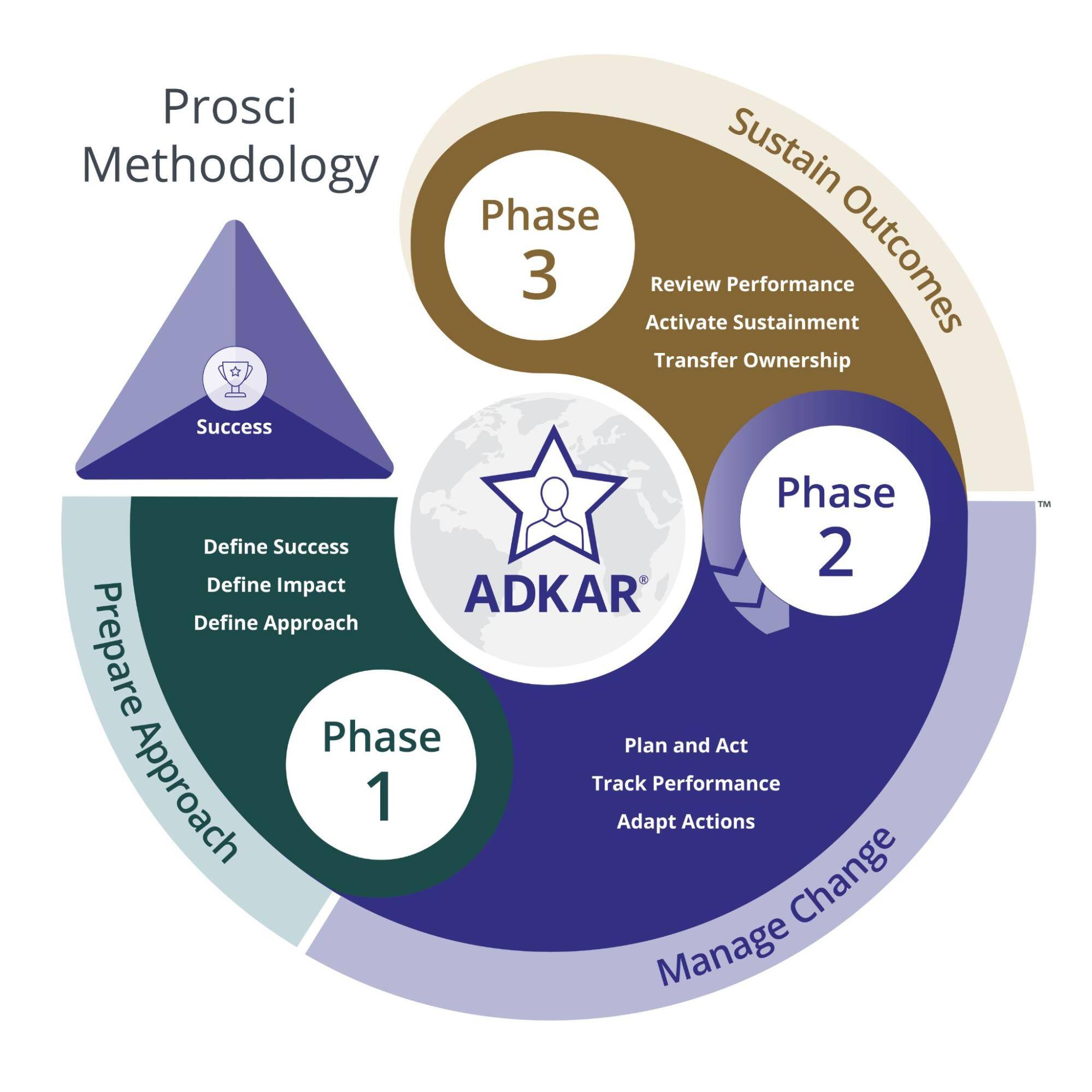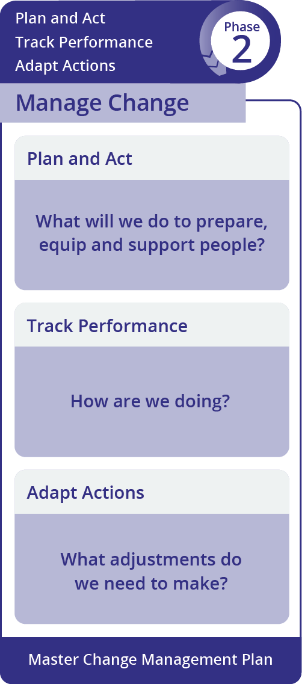
Prosci 3-Phase Process
A structured process for driving organizational change
The Prosci 3-Phase Process is one of the three main components of the Prosci Methodology, in addition to the PCT Model and the ADKAR Model. While the ADKAR Model enables successful change at the individual level, the Prosci 3-Phase Process provides a framework for achieving change at the organizational level.
Through this organizational change management process, change practitioners work through three phases (Phase 1– Prepare Approach, Phase 2 – Manage Change, Phase 3 – Sustain Outcomes) to achieve successful project outcomes.
Each phase is broken down into three stages, and each stage includes important activities to support the success of a change initiative. Although the Prosci 3-Phase Process is structured, it is also adaptable and scalable to fit the needs of any organization or change initiative.


Prosci’s comprehensive approach is straightforward, research-based, and easy to use, and it aligns with our strategic direction. This partnership is fundamental to our success.
– Gary Vansuch, Colorado Department of Transportation
Phase 1 – Prepare Approach
The first phase of the Prosci 3-Phase Process supports change and project teams in developing their change management strategy, and with the end in mind. The activities in this phase help practitioners develop a customized and comprehensive approach that positions their change for success. The three stages in Phase 1 – Prepare Approach include:
- Define Success – Practitioners establish precisely what they are trying to achieve, with activities such as developing a detailed change profile and defining what success on the project looks like
- Define Impact – This stage focuses on how the change impacts individuals, using activities that include identifying impacted groups and defining adoption and usage
- Define Approach – Here, practitioners consider what steps they will need to take to achieve project success, engaging in activities such as assessing risk, identifying potential resistance, and establishing required roles
 The deliverable for this phase is the Change Management Strategy, which establishes the approach needed to deliver desired project outcomes.
The deliverable for this phase is the Change Management Strategy, which establishes the approach needed to deliver desired project outcomes.


Phase 2 – Manage Change
The second phase of the Prosci 3-Phase Process brings the Change Management Strategy to life. The activities in this phase involve developing plans and actions that help move individuals and the organization through ADKAR transitions. The three stages in Phase 2 – Manage Change include:
- Plan and Act – Practitioners establish how to best prepare, equip and support people who will be impacted by the change, with activities like developing an ADKAR Blueprint and producing change management plans such as a Sponsor Plan and Communications Plan
- Track Performance – This stage focuses on how to track and sustain progress in the change management efforts, using activities that include establishing a tracking calendar and identifying performance strengths and opportunities
- Adapt Actions – Based on what practitioners have learned so far, particularly in the previous stage, they spend important time adjusting their change management strategy with activities such as preparing adaptive actions and continuing to track performance
 The deliverable for this phase is the Master Change Management Plan, which consolidates individual plans and serves as the guiding document for the change management team.
The deliverable for this phase is the Master Change Management Plan, which consolidates individual plans and serves as the guiding document for the change management team.
Phase 3 – Sustain Outcomes
The third and final phase of the Prosci 3-Phase Process establishes the approach for ensuring that the change is adopted and the organization is committed to doing what’s needed to sustain the change. Related activities involve reassessing performance, activating sustainment strategies, and transitioning responsibilities. The three stages in Phase 3 – Sustain Outcomes include:
- Review Performance – Following project go-live, practitioners reflect on performance to confirm desired results, with activities such as reviewing ADKAR outcomes and documenting lessons learned
- Activate Sustainment – Here, practitioners focus on implementing actions to sustain change outcomes, engaging in activities like identifying gaps and activating relevant sustainment roles
- Transfer Ownership – In this final stage of the Prosci 3-Phase Process, practitioners establish how to carry sustainment efforts forward, with important activities that include transferring knowledge and assets, as well as celebrating change management successes
 The deliverable for this phase is the Change Management Closeout, which documents the change performance status, plus prepares the organization to own and sustain change outcomes.
The deliverable for this phase is the Change Management Closeout, which documents the change performance status, plus prepares the organization to own and sustain change outcomes.

An Introduction to Change Management Guide

The data is clear: even when organizational changes meet technical requirements and milestones, they can still fail to deliver results and benefits. What’s missing? Change management. Organizations that embrace change management are more likely to achieve project objectives, stay on or ahead of schedule, and stay on or under budget.